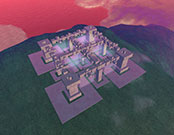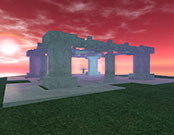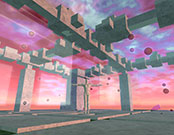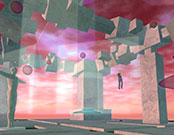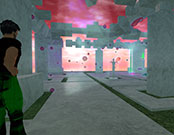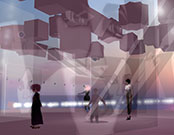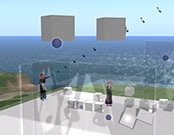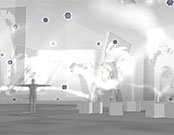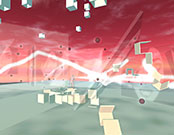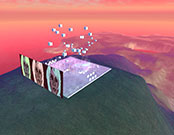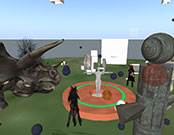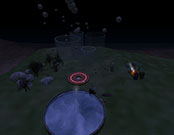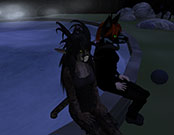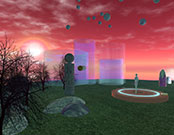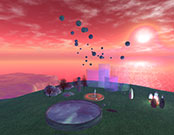Changing Room
v2.0 by: Michael Takeo Magruder with Drew Baker & collaborating artists, 2010
A mixed-reality installation exploring the mutability and reusability of artefacts, concepts and situations in the Digital Age.
About the Artwork:
Changing Room is an evolving artwork that considers the transitory nature of shared, virtual and mixed-reality environments and the creative potential of working within these liminal spaces. Blending the shared virtual environment of Second Life with the main recording studio of the Sonic Art Research Centre (SARC) at Queen's University Belfast, the artwork facilitates the realisation, curation and documentation of distinct – yet interrelated – art projects arising from a common pool of virtual and physical resources. Over the course of the Sonorities Festival of Contemporary Music, a series of creative teams will be invited to use the spaces and materials to realise works of their own conceptual and aesthetic design. Each project will last for a single day, after which, it will be documented in situ and then be handed over to a new group for repurposing.
The installation's main virtual element is an empty space and set of 128 primitive objects (prims) located within Second Life which can be fully modified using the environment's in-world toolset. Resident artists are provided exclusive rights to transform and programme these digital structures, but cannot generate their own objects within the space. If any of the artwork's prims are deleted or removed from the area, a series of scripts will instantly regenerate them in their original, given state.
Situated in SARC's main recording studio, the artwork's physical component is an immersive sound system and large-scale projection artistically arranged within the area. Live audio and video from the virtual environment are streamed into the physical space through a Doll (a virtual body devoid of human agency that is used to 'sense' and transmit aspects of a virtual world). Visitors entering the area are tracked by a hidden motion sensor that relays its data to the virtual realm. The presence of spectators in the physical space causes additional prims, each having just a 12-hour lifespan, to be generated within the virtual world for resident artists to use.
Process:
The artwork's initial configuration will be exhibited without alteration for a period of one day. Direction over the virtual and physical resources will then be relinquished to an artistic team that will be given exclusive access to remix and modify the spaces according to their own designs. At the beginning of each new day, control will be ceded to another group, thus continuing the process.
At the conclusion of each team's session, photographic, video and textual documentation will be collected both virtually and physically. An exact copy of the permanent prims will be taken in order to archive a 3D 'snapshot' of that group's virtual creation, thereby serving as a record of the artwork's main transitions. The archived copy will also be returned to the creators so that they can reinvestigate their work in other locations and times. Although each of the individual sessions will be intrinsically linked to the process as a whole, they will not necessarily be dependent on one another, so that the independent works can persist and evolve according to their own trajectories after the project's completion.
Materials:
Virtual: 128 permanent prims, (up to) 128 temporary prims, plinth, (avatar) Doll and scripted control units.
Physical: Computer, custom-built motion sensor, HD projection and 5.1 surround sound system.
Experience Version 2.0:
Virtual: 4-7 November 2010, Transitional Space, Second Life: A Windows/Mac/Linux computer system running the current Second Life client is required to visit the shared virtual environment. A high-specification CPU/GPU, 5.1 or stereo audio, a colour display with ≥1024x768 resolution and a 1Mbps+ Internet connection are recommended.
Physical: 4-7 November 2010, Sonic Art Research Centre, Queen's University Belfast, UK: Visit the shared physical environment as part of the Sonorities Festival of Contemporary Music.
Documentation:
With Projects by:
[04/11/2010] initial configuration by Michael Takeo Magruder (as 'Takeo Takacs' & 'ChangingRoom Monday')
[05/11/2010] Drew Baker (as 'Melancholy Graves') and Michael Takeo Magruder (as 'Takeo Takacs')
[06/11/2010] Steve Millar (as 'Arahan Claveau') and Selavy Oh (as 'Selavy Oh')
[07/11/2010] Ana Benlloch (as 'Ana Vemo'), Rachel Darke (as 'Lledrith Darracq') and Antonio Roberts (as 'Overload Afterthought')
In Collaboration with:
Drew Baker [ Second Life programming ] . Steve Millar & Selavy Oh [ artistic team 1 ] . Ana Benlloch, Rachel Darke & Antonio Roberts [ artistic team 2 ]
With Thanks to:
Franziska Schroeder (SARC) [ curation ] . John Osburn (SARC) [ technical setup ] . Hugh Denard [ discourse ]
Supported by:
Changing Room is an experimental prototype for EP:VV (Eastside Projects: Virtualised and Visualised) – an initiative seeking to develop online, multi-user environments promoting new models of artistic participation and representation within a gallery context. EP:VV is a collaboration between Eastside Projects, the Visualisation Research Unit, Birmingham City University and King’s Visualisation Lab, King’s College London, made possible through funding by Arts Council England.
Artwork Requirements:
Virtual: Windows/Mac/Linux computer system with the current Second Life client and stereo audio. A high-specification CPU/GPU, colour display with ≥1024x768 resolution and high-speed Internet connection are recommended.
Physical: HD projector, computer (with the Second Life client), custom-built motion sensor and 2.1 sound system.
